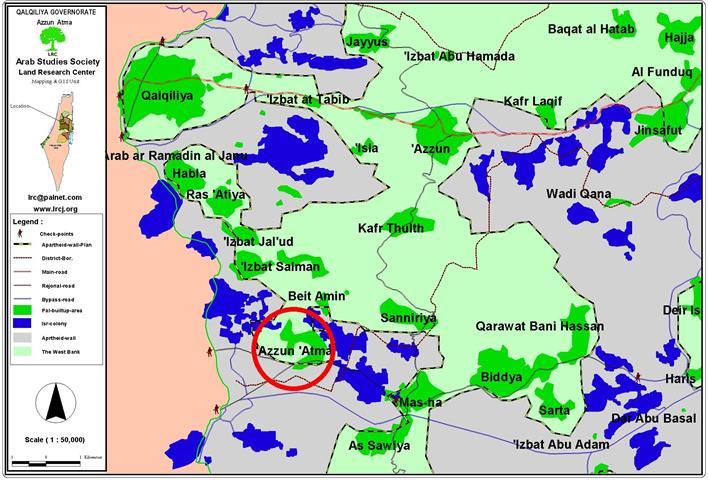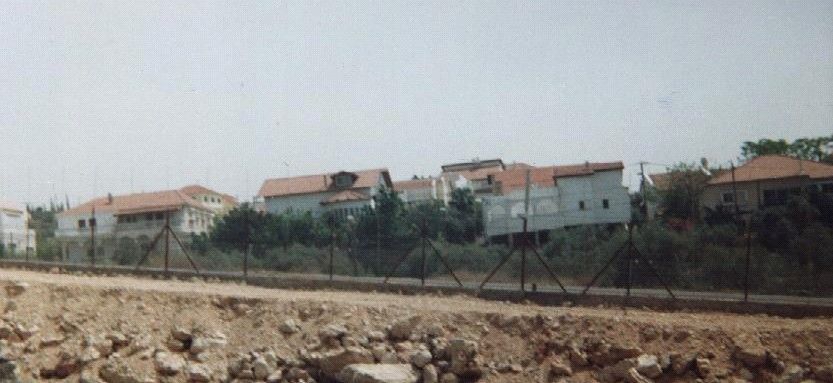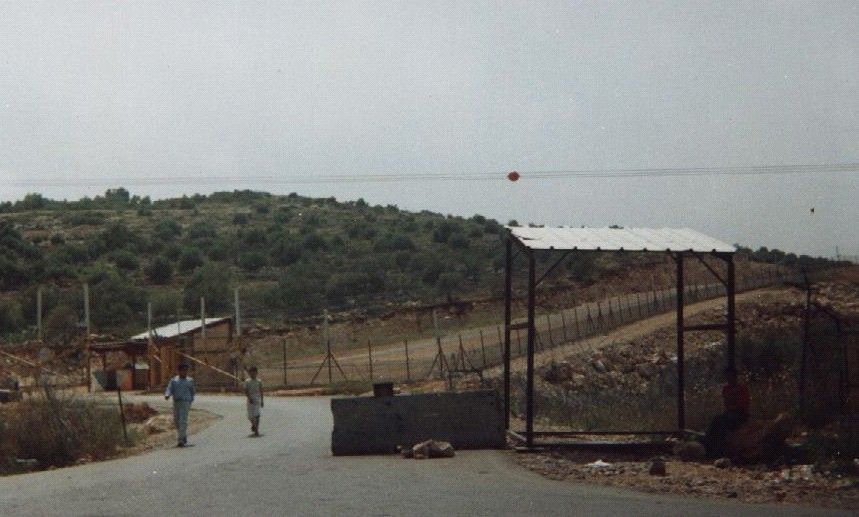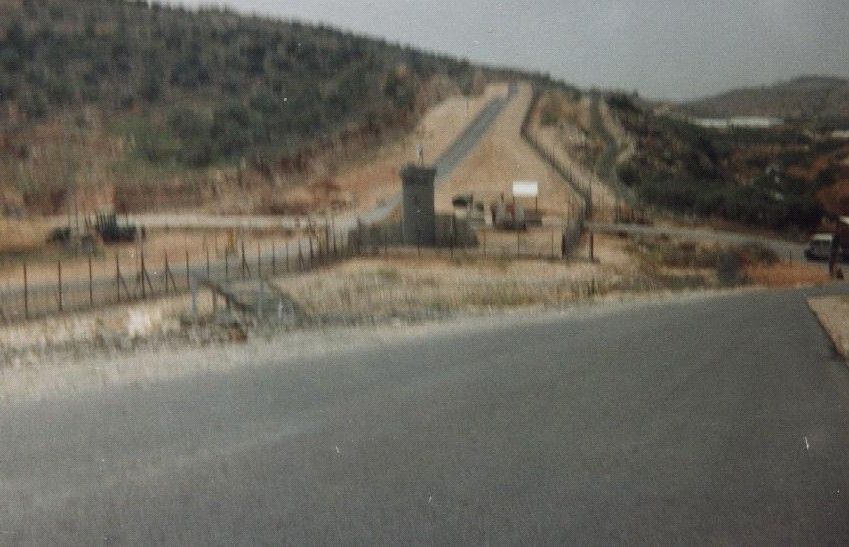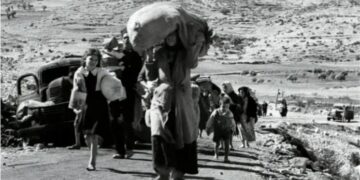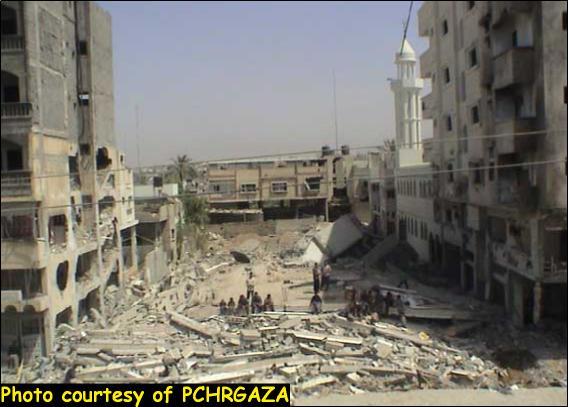Location and Population:
The village of Azzun is located two kilometers to the east of the Green Line and is about 11 kilometers away from Qalqilia's southeastern side . Its lands extend from Beit Amin village border in the north, to Al Sawiya village in the south as well as from the Green Line in the west to the vicinity of Sneiria village in the east.
Practically, the village is considered to be a natural extension of the nearby village of Sanniriya as a number of Sanniriya residents left it at favor of Azzun fertile lands. See Map of location
The village of Azzun- Atma ( in red circle) besieged by the Wall from all sides
The population of the village before the year 1967 was about 500 after which it was reduced to 300 as a direct effect of the 1967 War. The village houses a number of families, the largest of which is Ahmad family since it constitutes about 45% of the village's population. Al Sheikh family is the second largest and represents 25% of the total population. Smaller families, such as Yunis, Abu Hijla, Rabi and Moa'amar, also exist.
The village's Labor Force:-
Before 1967, about 99 % of the villagers ( which constituted the majority that time) depended on agriculture and herd raising as their main source of income. The remaining 1% used to work in governmental positions. During the period of 1967 and 2002, about 95 % of the village's workforce depended on working in Israel in addition to agriculture, while the remaining 5 % worked in private and public institutions. The eruption of the recent Intifada in late September 2001 rendered more than 60 % of the village's population to become unemployed.
Village Area
The total area of Azzun village is about 5,000 dunums, out of which, 800 dunums are used for growing crops in plastic houses, 200 dunums used for house constructions, while the remaining 3,300 dunums are cultivated with olive trees.
In 1987, about 700 dunums of the village's land were expropriated and used by the Israeli authorities to build two settlements: Oranit settlement, located northwest of azzun village and Sha'are Tikva settlement located northeast of the village. See Photo 1
The settlement of Sha'are Tikva surrounded by the Apartheid Wall, Photo courtesy of LRC
Israeli Apartheid Separation Wall
The main goal of the Wall is to instigate a Palestinian migration through the transformation of their villages and cities into easily controllable cantons. In the case of Azzun Atma, Oranim and Sha'are Tikva settlements extended throughout the years to surround the village from its eastern and southern directions.
The Effects of the Israeli Apartheid Separation Wall
A) Economical Effects
The erection of the Israeli Segregation Wall has led to the plowing of more than 700 dunums of agricultural lands including 50 dunums were used for plastic houses in addition to 650 dunums cultivated with more than 2100 olive trees. Such trees were uprooted and later transported to Israel for replantation. Moreover, the establishment of the Wall led to the confiscation of a water well (called Abu Hijla well) with a capacity of 150,000 water cubes meter per month. Barbed wires surround the well from all directions and no one is allowed to approach it.
The erection of the Wall has led to an increased difficulty in transporting goods, mainly agricultural goods and crops upon which more than 90 % of the economy of the village rests, and restricted the movement of the Palestinian residents entering to and coming out of the village. Israeli forces only allow Azzun's ID holders to enter the village which led to a decrease in the labor force and the spoilage of the agricultural crops.
B) Social Effects
Given the fact that the village of Azzun is surrounded by the Wall, a number of Israeli Israeli settlements and the Green Line in addition to one iron gate at the northern tip of the village which controls the passage of Azzun villagers through it, has led to the cut off of social relations between families and freinds. Moreover, The IOF adopted a policy of issuing visitation permits for those wishing to visit their family members living inside Azzun. It has also been documented that even when Israel issues such permits, soldiers manning the gate do not respect the permits and most of the times residents are prevented from accessing the village. See Photo 2
Azzun Atma: The sole gate north of the village which is the only passage out let available for the village citizens.Photo courtesy of LRC
The iron gate which is considered the only access to and from Azzun village is opened on stages during the day. Residents of Azzun are only allowed to enter the village through between between 6 AM and 4 PM. Yet, due to continuous protests, occupation forces changed those times to span between 6 AM and 10 PM.
C) Educational Effects:
Students from the nearby village of Beit Amin lack a high school in their village which forces them to attend the one located in the village of Azzun. Students, most of the times, face a series of humiliation measures committed by the Israeli soldiers guarding the military gate. Such measures have caused daily delays for both students and teachers who find themselves forced to wait in rows and for a long period of time; thus, forcing restriction on movement as Palestinians move into and out of the area.
As for the teaching staff, they have to coordinate before in advance with the DCO to get special permit to allow them to get into the village. Again, it has been the case that the Israeli soldiers would seal the gate for days in a row under the pretext of ''security'' which, in turn, would lead to the disruption of the educational process. See Photo 3..
Azzun Atma: The sole gate north of the village protected by any army tower and other fortifications and early warning systems. Photo courtesy of LRC
D) Health Effects
Medical crew entering the village of Azzun need to coordinate first with the relevant Israeli authorities before being allowed to enter the village. This in turn opposes their their work in the village, at the same time blocking the process of supplying the village with medical services. Moreover, sick people are prevented from accessing medical centers outside of the village between 10:00 PM and 6:00 AM due to the closure imposed on the city during that period of time.
E) Psychological Effects
The view of the Wall surrounding the village and the ill treatment and continuous humiliation citizens face at the checkpoint cause depression. Moreover, the intermittent use of sound bombs and gun fire by the Israeli soldiers and patrols cause feelings of distress and fear among the children, women and men of the village alike.
LRC's Field Visit
During the visit of LRC fieldworkers to the village, they met a number of citizens who are seriously affected by the construction of the Wall. They included:
-
Mr. Rafeeq Mahmoud Husein Al Sheikh said that: 'the Racist Wall has led to the disruption of the educational process on daily basis due to the Israeli soldiers' actions who are manning the gate.''
-
Mr. Riyad Al Sheikh who is a resident of Azzun while his wife carries an ID card in which she is registered as one of Sanniriya village residents. Mr. Al Sheikh mentioned that Israeli soldiers have prevented his wife from entering the village due to the fact that she has the ID of Sanniriya which forced him to leave his house in the village and rent another one in Sanniriya to assure his family's reunion.
Prepared by
The Land Research Center
LRC


